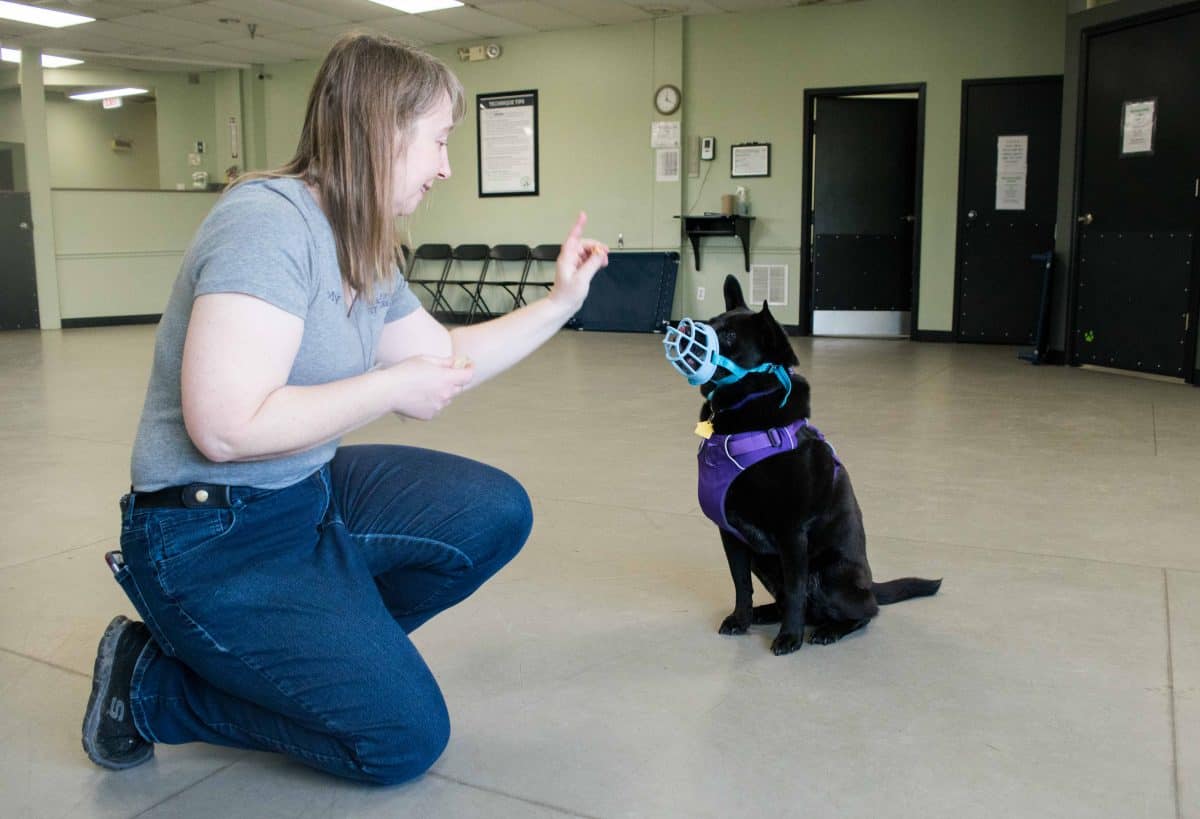The Benefits of Using a Dog Muzzle

At The Academy of Pet Careers, all students (both grooming and training) learn to acclimate dogs to wearing a muzzle because it’s such an important skill to have. And as a professional trainer and behavior consultant, I believe that every dog should learn to be comfortable wearing a muzzle.
Many people cringe at the thought of putting a muzzle on their dog. Walking down the street, if you see a dog wearing a muzzle your first thought might be “that dog must be vicious”. But the truth is, there are many, many reasons why a dog might be wearing a muzzle. Aggression is just one possible reason.
Why Muzzle Training Should Be a Standard Practice
Pain and Discomfort
Teaching a dog to be comfortable with a muzzle just makes good sense. You never know when she might need to wear one for her safety or the safety of others. For example, when a dog is injured, she is scared, in pain, and her tolerance is significantly lower. In that moment, your sweet and gentle dog may be far more likely to bite.
I acclimated my own dog to wearing a muzzle because he should be comfortable in one. Then six weeks later, my pup tore his ACL. He screamed in pain and was limping severely. I began assessing him to determine what part of him hurt. As my hand brushed his knee, his head whipped around and with his mouth open, the flat of his tooth touched my hand. He didn’t bite me. But it’s the closest he’s ever come!
I took him directly to the vet and put his muzzle on before we got out of the car. Because he was used to wearing a muzzle, this did not add another layer of stress or fear for him. And the vet was able to examine him in less than 60 seconds without worry or risk of being bit. We had a diagnosis and treatment plan in less than 5 minutes because that muzzle allowed the vet team to work swiftly and safely.
Control Eating
Injury is just one scenario where wearing a muzzle is a useful skill. If you have a dog who eats everything she sees, teaching her to wear a muzzle allows you to protect her safety (keep her from ingesting foreign objects) while working on a solid Leave It skill.
Fear of Surroundings
If she’s fearful of strangers approaching, putting a muzzle on gives a silent cue to passing people to please keep a distance. Or, if there’s a natural disaster, most shelters will not allow dogs to stay with their people. But if your dog is trained to wear a basket muzzle comfortably, you might be able to keep your beloved pet with you during that stressful and scary time.
Safety Factor
And, of course, there are times when it is a safety factor. Your dog may have a strong prey instinct and want to attack critters, or she may be reactive to dogs or strangers. In these cases, using a muzzle is a critical piece in any behavior plan. Many dog groomers work with muzzles for this exact reason. It protects them and reduces the risk of a reactive bite or injury.
It provides a layer of protection so that your dog cannot severely damage anyone. That barrier allows you to relax a little (knowing you have a layer of protection) and lets you focus on the behavior protocol you’re implementing with the help of your trainer/behavior consultant.
Muzzle Types
There are two basic types of muzzles. Cloth muzzles that prevent the mouth from opening at all and basket muzzles. These muzzles are often used in veterinary offices when a procedure must be done and a dog is showing increased stress and is a greater risk for biting. Cloth muzzles should not be worn for more than 10 minutes and the dog should never be unsupervised while wearing one.
Basket muzzles (shown in the pictures) are larger and somewhat cage-like. They may be made of soft, malleable rubber or rigid plastic. Or they may be made of metal or leather. Baskerville Muzzles are a commonly used brand in our line of work. These muzzles are designed to allow the dog to open her mouth so she can pant, drink water, show facial expressions, and (most importantly) take treats. Basket muzzles can be worn for longer periods of time (still always supervised) and can be used during behavior modification because we can provide treats while the muzzle is on – allowing us to help the dog create better associations with things that scare or upset her.
Check out our article on how to muzzle train your dog!
Author - Jody Epstein
Jody Epstein is a certified behavior consultant, certified professional dog trainer, and holds a master’s degree in animal behavior from Tufts University. She has been training professionally for more than 12 years and is pleased to be part of the Academy of Pet Careers team, teaching the next generation of trainers. Look out for her blogs on all things dog training and animal behavior.

